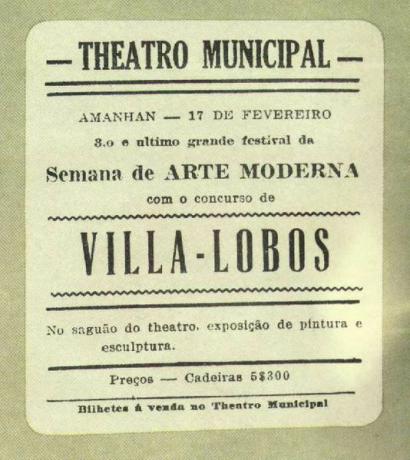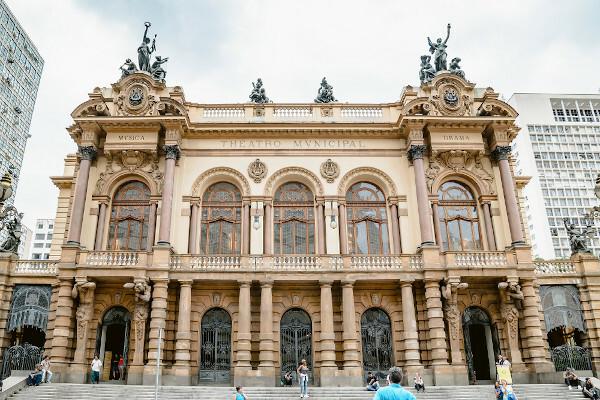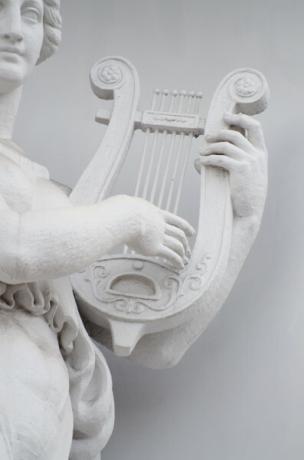official landmark of Brazilian Modernism, a Modern Art Week took place in São Paulo (SP) and brought together artists from the most diverse areas in the Municipal Theater of São Paulo over the days February 13 and 18, 1922. Musical presentations and conferences were interspersed with sculpture, painting and architecture exhibitions, with the aim of introducing the newest art trends to the Brazilian scene.
Influenced by European vanguards and for general renewal in the panorama of western art, these writers, painters, sculptors, intellectuals and musicians joined their efforts to present their productions to the general public. A meeting of the aesthetic trends that have taken shape in São Paulo and Rio de Janeiro since the beginning of the century, the Week of Modern Art also revealed new groups, new artists, new publications, making modern art a cultural reality in Brazil.

Historical context of the Week of Modern Art
Until the beginning of the 20th century, the artistic school considered official in Brazil was the Parnassianism. Characterized by formal rigor (concern with the form of the poem with regard to metrification), by the proposal of "art for art" and by academicism and high scholarship, O Parnassianism it had been the dominant aesthetic trend until then, especially in poetry, appearing in official texts such as the Brazilian National Anthem.
Like the vast majority of aesthetic schools, Parnassianism was imported from Europe. On the European continent, however, another artistic proposal prevailed. The big turnarounds of Industrial Revolution had instituted a new way of living, completely modifying human relationships. Electric light and the speed of automobiles and large-scale factory productions transformed society.
Do not stop now... There's more after the advertising ;)
the advent of First World War (1914-1918) and the deadly destruction caused by it also socially and philosophically influenced the artists of the period. The beginning of the 20th century brought numerous changes the European way of life; art, therefore, needed to keep up with these changes. The artistic avant-gardes surfaced and, with them, the consolidation of modernity in the field of art.
Brazil, in turn, was also beginning to modernize. The first industries started to settle in the city of São Paulo, and the production of coffee in the interior of São Paulo generated great export revenues, transforming the state into a new Brazilian economic center. For this reason, the capital of São Paulo was the stage for the events of the Modern Art Week, which was sponsored by several members of the industrial bourgeoisie which was consolidated there.
Furthermore, 1922 was the centenary of Independence of Brazil. Thus, the setting was ideal for the national artistic renewal, and this was one of the themes of the Week: The intellectual update of the national conscience. Brazil, which was transforming and modernizing itself, needed a new artistic, sociocultural and philosophical perspective that proposed a original and updated national art, bringing with it a thought about Brazilian problems and the cultural variety that spread across our vast territory.
Important predecessor of the week was the Exhibition of Modern Painting – Anita Malfatti, which took place in 1917, also in São Paulo. Fifty-three works by the painter were presented alongside works by international artists linked to the European avant-garde. The screens impressed names that would later lead the Week, such as Mario de Andrade, Oswald de Andrade, Menotti del Picchia and Di Cavalcanti.
The exhibition also caused great disapproval of conservative critics, in particular Monteiro Lobato, who published an extremely negative review, entitled "Paranoia or mystification?". With expressionist traits, Malfatti brought to Brazil a new aesthetic, in an exhibition considered to be the first “fuse” for the idea of the Week.
The new trends that flourished with the avant-gardes, a great period of experimentation at the beginning of the 20th century, gave to Brazilian artists the possibility of working with new languages, new materials and new proposals, in order to in renew national art. But, unlike Parnassianism, there wasn't a complete incorporation of these aesthetics – it didn't matter to Brazil the cubism or the expressionism seeking to develop an analogous school here.
The artists who initiated Brazilian Modernism took advantage of these new procedures and techniques, this break with academicism, to re-elaborate the national artistic scene.
"Modernism, in Brazil, was a rupture, it was an abandonment of principles and consequent techniques, it was a revolt against what was national intelligence." [1]
See too: The representation of blacks in Brazilian literature
How was the 1922 Modern Art Week?
Between February 11th and 18th, the Municipal Theater of São Paulo remained open for visitation. In its lobby, a painting and sculpture exhibition. Works by Anita Malfatti, Di Cavalcanti, Victor Brecheret, among others, scandalized the Brazilian public taste, not used to the new forms of representation proposed by modernism.
Boos, rumbles and general agitation only increased throughout the week. In addition to the exhibition, the event featured three festivals, which involved music, dance, poetry recitations and conferences, to take place on February 13th, 15th and 17th.

grace spider, who at the time was already an acclaimed Brazilian writer and intellectual, did the honors of festival opening, on the 13th, with the conference entitled “The Aesthetic Emotion of Modern Art”. He was respectfully listened to by the public and recited verses by Guilherme de Almeida and Ronald de Carvalho, accompanied by songs performed by maestro Ernani Braga.
Also on the 13th, the aforementioned poet Ronald de Carvalho he was at the head of his own conference, entitled “Painting and modern sculpture in Brazil”, followed by three piano solos by Ernani Braga it's three African dances by Villa-Lobos – composer, by the way, recognized at the time as “talent not yet cultivated enough”, for his music “Deprived of good sense” and “Purely African”.
The day February 15th it represented the height of the Week, in the most scandalous terms. The new literature provoked irritation and uproar in the audience present. stand out the lecture by Mario de Andrade, whose text would later become the publication The slave who is not Isaura, in which the author emphatically defends the Brazilianization of the Portuguese language, and the conference on modern aesthetics uttered by Paulo Menotti del Picchia, which stirred the spirits of the audience, echoing boos in the four corners of the Theatro.
Also on that day there was a soiree, which had the participation of several writers, who tried to speak amidst the screaming of the audience. On that day, Ronald de Carvalho read the famous poem “Os Sapos”, authored by Manuel Bandeira, who ridiculed the Parnassians. Read an excerpt:
the frogs
Puffing up the conversations,
Come out of the dimness,
Jumping up, the frogs.
The light dazzles them.
In a roar that lands,
yells the bullfrog:
— 'My father went to war!'
- "It was not!" - "Was!" - "It was not!".
the cooper toad,
watery Parnassian,
It says: — "My songbook
It's well hammered.
see like cousin
In eating the gaps!
What art! And I never laugh
The cognate terms!
my verse is good
Taresless fruit
I rhyme with
Support consonants.
goes for fifty years
Which I gave them the norm:
I reduced without damage
To form to form.
claim the shoe
In skeptical reviews:
There is no more poetry,
But there are poetic arts.. .
[...]”
(Manuel Bandeira)
Mario de Andrade also gave a brief lecture, on the Theatro's internal staircase, about painting works. Twenty years later, the author recalled the episode in the work The Modernist Movement, commenting: “How could I give a conference on plastic arts, on the steps of the Theatro, surrounded by anonymous people who made fun of me and offended me for real...”. The audience's great confusion only calmed down with the presentations that ended the day: dance numbers of Yvonne Daumerie and the piano concert of Guiomar Novais.
the event of closing of the Week was dedicated to music. Parts of Villa-Lobos they were performed by the various participating musicians, with less booing noises, but not without escaping the sharp criticism of conservatives.
Also access: Oswald de Andrade – one of the precursors of Modernism in Brazil
Top artists of the 1922 Modern Art Week
- architects: Antonio Moya, Georg Przyrembel.
- writers: Afonso Schmidt, Agenor Barbosa, Álvaro Moreyra, Elysio de Carvalho, Graça Aranha, Guilherme de Almeida, Luiz Spider, Mario de Andrade, Menotti del Picchia, Oswald de Andrade, Ronald de Carvalho, Sérgio Millet, Tacito de Almeida.
- sculptors: Wilhelm Haarberg, Hildegardo Leão Velloso, Victor Brecheret.
- musicians: Alfredo Gomes, Ernani Braga, Fructuoso Viana, Guiomar Novais, Heitor Villa-Lobos, Lucília Guimarães, Paulina de Ambrósio.
- painters: Anita Malfatti, Antonio Paim Vieira, Emiliano Di Cavalcanti, Ferrignac, John Graz, Vicente do Rego Monteiro, Yan de Almeida Prado, Zina Aita.
Consequences of the 1922 Week of Modern Art
Controversial, confused, noisy, considered “too festive” and “not modern”, it cannot be denied that the Week of Modern Art in 1922 was a milestone, a watershed in the Brazilian artistic panorama. It opened wide the doors to great freedom with regard to aesthetic production and research in the country, contributing to a intellectual and artistic flourishing. In the view of Di Cavalcanti, the event of the Week went beyond the cultural field and also had repercussions in the political area.
The Week played the role of dissemination of modern art, which, in turn, cultivated the ground for the consolidation of a artistic and literary revolution that took shape after 1922, when Oswald de Andrade's manifestos and the fundamental works of the First Brazilian Modernism, such as Macunaíma (Mario de Andrade), Sentimental Memories of João Miramar (Oswald de Andrade) and Dissolved Rhythm (Manuel Bandeira).
Read too: Carolina Maria de Jesus - known for her diaries in the Canindé favela
1922 Modern Art Week Summary
- It took place between February 13 and 18, 1922, at the Municipal Theater of São Paulo;
- It is considered a landmark in Brazilian Modernism;
- It brought together artists from different areas: painting, sculpture, architecture, music, dance, literature;
- Directly or indirectly, famous names in Brazilian art participated, such as Graça Aranha, Oswald de Andrade, Menotti del Picchia, Ronald de Carvalho, Mario de Andrade, Anita Malfatti, Heitor Villa-Lobos, Victor Brecheret, Di Cavalcanti, Guiomar Novais, among others;
- Paintings and sculptures were exhibited in the lobby of the Theatro and caused a great scandal in the public taste of the time;
- Conferences, soirees and dance and music performances took place within three days of the event;
- It consolidated the favorable environment for the publication of several works that characterized the First Generation of Brazilian Modernism (Generation of 20).
Grades
[1] ANDRADE, Mário de. Aspects of Brazilian Literature. São Paulo: Martins, 1974. P. 23.
Image credits
[1] Vinicius Bacarin / shutterstock
by Luiza Brandino
Literature teacher

